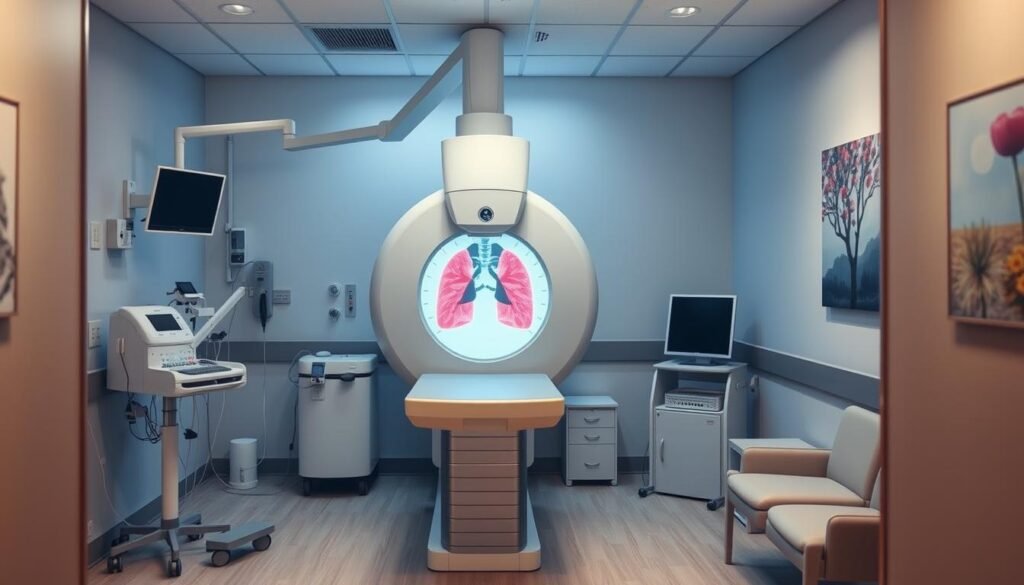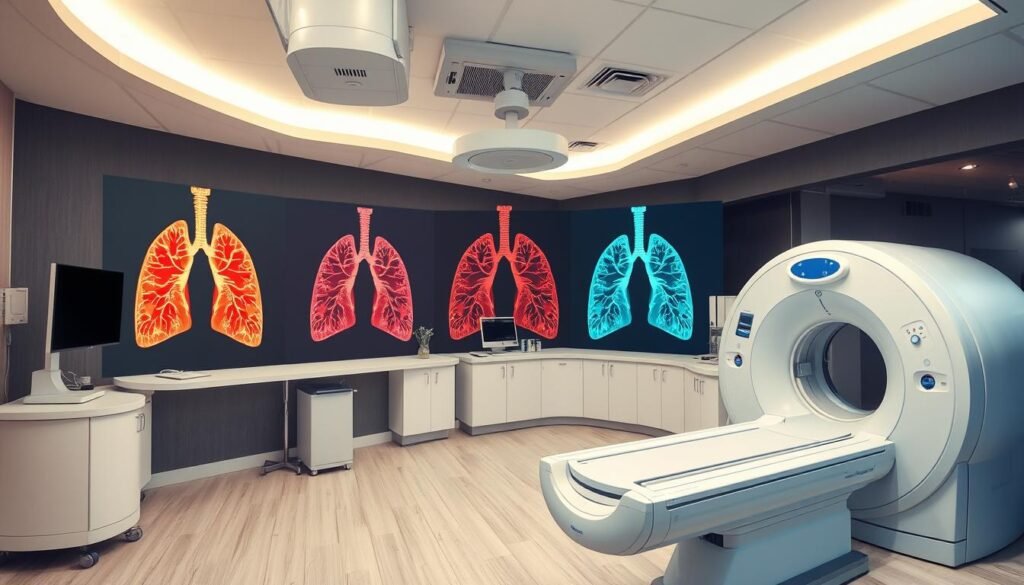About 85% of lung cancer is Non-small Cell Lung Cancer (NSCLC). This fact stresses the need for early spotting. Since lung cancer is the top cause of cancer deaths worldwide, catching it early is key. It improves survival rates and lung health a lot.
If found early, people with stage IA1 NSCLC mostly live five years or longer. Yet, only 10% in stage IV have these odds. Early detection means more and better treatment choices. It also means less drastic treatments and a bigger boost in mental health.
Groups like Biodesix are making lung cancer screening better. They show how important regular checks are in health care. It’s vital that high-risk people, like smokers, get these tests. Early detection changes a diagnosis into steps that can save your life. For more info on how early checks can save lives, see early lung cancer screenings.
Key Takeaways
- 85% of lung cancer cases are NSCLC, emphasizing the need for early detection.
- Stage IA1 NSCLC has a 5-year survival rate of 92%, compared to just 10% for stage IV.
- Early detection not only improves treatment options but also enhances the quality of life.
- Regular screenings are vital for high-risk individuals, especially smokers.
- Organizations are innovating to integrate cancer screening into everyday healthcare.
Understanding Lung Cancer
Lung cancer is a major health problem in the United States. It causes more deaths than breast, prostate, and colorectal cancers combined. Knowing about the types of lung cancer is key to fighting it. There are two main types: Non-small Cell Lung Cancer (NSCLC) and Small Cell Lung Cancer (SCLC). Each type needs a different way to handle it.
Many things can lead to lung cancer. Smoking is the biggest risk. But harmful substances like radon gas, asbestos, and genetics are also dangerous. There’s a false belief that only smokers get lung cancer. Yet, many non-smokers get it too. This shows why everyone needs to know more about this disease.
Understanding lung cancer can help prevent it and find it early. The chance of living five years after diagnosis is about 21%. But if found at stage I, survival rates jump to nearly 90% with early screening. More knowledge and early action can change lives and clear up wrong beliefs.
| Lung Cancer Type | Survival Rate | Main Risk Factors |
|---|---|---|
| Non-small Cell Lung Cancer (NSCLC) | Varies by stage; early detection improves outcomes significantly | Smoking, asbestos exposure, radon |
| Small Cell Lung Cancer (SCLC) | Lower than NSCLC; aggressive nature | Smoking, genetic factors |
What is Early Lung Cancer Detection?
Early lung cancer detection is about finding the cancer early. This is when treatments work best. It uses tools like low-dose CT scans and bronchoscopy. Diagnostic imaging and cancer screening processes help doctors see signs of cancer early. This boosts the odds of beating the cancer.
Studies show early detection can save lives. Lung cancer is the top cancer killer. Most people find out too late, which makes it harder to treat. Finding cancer early means a better chance of surviving. In fact, 90% of people with stage I lung cancer live five more years.
But there are hurdles in using low-dose CT scans everywhere. They can be expensive and use radiation. This makes repeated tests a concern for some.
Scientists are finding new ways to spot lung cancer early. One exciting development is using blood tests. This method checks the blood for cancer signs without having to use scans. You can learn more about this at early detection of lung cancer. Though hopeful, more research is needed to truly make this method widely used.
Benefits of Early Lung Cancer Detection
Finding lung cancer early is key to better outcomes for patients. It means more treatment choices and better chances of living longer. Knowing this can push people to get screened early for their health.
Improved Survival Rates
Research shows finding lung cancer early greatly improves your chances of surviving. People caught at stage I have much better odds than those found later. Low-dose CT scans offer a 20% chance of living longer for those at high risk.
This study shows early detection clearly saves lives. The National Lung Screening Trial found 63% of cancers early with LDCT. This is way better than finding 29.8% of cancers late at stages III or IV.
Enhanced Quality of Life
Catching lung cancer early also means a better life for patients. Early treatments are usually easier on the body, causing less harm. This lets patients enjoy life and stay active during and after treatment.
Exploring treatment early shows huge benefits in health care. It’s clear that early diagnosis is super important for a good life.

Importance of Screening
Lung cancer screening is vital in lowering lung cancer death risks. It is recommended for older adults who smoked a lot in the past. If you have a smoking history of 20 pack years or more, you might need screening.
Screening could be crucial for those who quit smoking after years of heavy use. Do this within 15 years of stopping. But, it’s not for those with very bad lung function or other serious health issues.
Screening does more than find cancer. It can also find other lung and heart problems in long-term smokers. About half the people screened might find nodules through LDCT scans. These scans use a little bit of radiation to see inside your lungs.

Early detection is key in screening. But, finding something unusual means you might need more tests. These tests could expose you to more radiation or be invasive. The goal is to catch lung cancer early to treat it better and prevent worse cases.
Despite the clear benefits, few eligible people get screened. Less than 6% of those who should, actually go for it. This shows a huge gap in understanding its importance. With lung cancer causing nearly 130,000 deaths in the U.S. this year, more screenings could save many lives.
Early Detection Methods
Finding lung cancer early is key to better treatment results. High-risk individuals must know about early detection methods. Chest CT scans and bronchoscopy are effective and precise in this regard.
Chest CT Scans
Chest CT scans are top-notch for spotting lung cancer in those at high risk, like heavy smokers. They show clear lung images, catching small tumors that X-rays might miss. This helps doctors keep a close eye on lung nodules, aiding early action.
Studies show that low-dose computed tomography (LDCT) screening lowers the death rate from lung cancer. The US Preventive Services Task Force suggests yearly LDCT scans for 50 to 80-year-olds with a heavy 20 pack-year smoking history. This is advised for current smokers and those who quit in the last 15 years.
Bronchoscopy Techniques
Bronchoscopy, along with chest CT scans, plays a big role in catching lung cancer early. The Ion robotic bronchoscopy tool lets doctors do lung biopsies with minimal invasion. It’s great for reaching and sampling nodules in tricky spots, boosting the odds of finding malign lesions.
Using bronchoscopy early means patients get faster treatment. This can greatly improve survival chances. The mix of sharp imaging and precise biopsy techniques gives a strong game plan against lung cancer.

| Early Detection Methods | Description | Benefits |
|---|---|---|
| Chest CT Scans | Detailed imaging tool for detecting lung nodules and tumors. | Effective early detection, reduces mortality risk. |
| Bronchoscopy Techniques | Minimally invasive method for biopsy of lung nodules. | Improves diagnostic accuracy, facilitates early treatment. |
Risks Associated with Late Detection
Finding lung cancer late can greatly harm a patient’s future and the care they can get. If lung cancer gets spotted in its later stages, usually stage III or IV, it advances fast. This means the 5-year survival rate drops to below 10%.
Dealing with late-stage lung cancer, patients face many health issues. This makes treatment harder. The more time cancer remains hidden, the more it might spread. This is called metastasis. It complicates treatment and shows why regular checks are important. Especially for people at higher risk. To understand how early detection, like low-dose CT scans, could help patients live longer, check this resource.
Also, studies find that about 85% of lung cancer cases are caught too late. This points out how crucial it is to know the dangers of finding it late. Early screening can help doctors improve patients’ survival chances. It can also make their lives better.